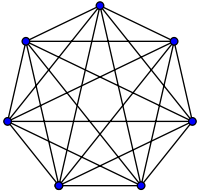Kán
Kán is the name of a Hungarian noble family which gave bans (governors) to Croatia and Slavonia, voivodes to Transylvania, and palatines to Hungary in the 13th and 14th centuries.
History
The Kán family were members of the Hermány clan. They crossed the Carpathian mountains together with Árpád, leader of the Magyars, and settled in Pannonia in 895. They were Counts of Siklós from the year 900.
Members
Notable members of the family include:

Kənəə
Coordinates: 40°51′N 48°18′E / 40.850°N 48.300°E
Kənəə (also, Kənə’ə, Kyanaga, and Kyanagya) is a village in the Ismailli Rayon of Azerbaijan. The village forms part of the municipality of Ərəkit.
References

Complete graph
In the mathematical field of graph theory, a complete graph is a simple undirected graph in which every pair of distinct vertices is connected by a unique edge. A complete digraph is a directed graph in which every pair of distinct vertices is connected by a pair of unique edges (one in each direction).
Graph theory itself is typically dated as beginning with Leonhard Euler's 1736 work on the Seven Bridges of Königsberg. However, drawings of complete graphs, with their vertices placed on the points of a regular polygon, appeared already in the 13th century, in the work of Ramon Llull. Such a drawing is sometimes referred to as a mystic rose.
Properties
The complete graph on n vertices is denoted by Kn. Some sources claim that the letter K in this notation stands for the German word komplett, but the German name for a complete graph, vollständiger Graph, does not contain the letter K, and other sources state that the notation honors the contributions of Kazimierz Kuratowski to graph theory.
Våk
Våk is a village in the municipality of Våler, Østfold, Norway. Its population (2005) is 1,021.
VK
VK may refer to:
People
Vampires

Vík í Mýrdal
The village of Vík (![]() pronunciation ; or Vík í Mýrdal in full) is the southernmost village in Iceland, located on the main ring road around the island, around 180 km (110 mi) by road southeast of Reykjavík.
pronunciation ; or Vík í Mýrdal in full) is the southernmost village in Iceland, located on the main ring road around the island, around 180 km (110 mi) by road southeast of Reykjavík.
Despite its small size (291 inhabitants as of January 2011) it is the largest settlement for some 70 km (43 mi) around and is an important staging post, thus it is indicated on road signs from a long distance away. It is an important service center for the inhabitants and visitors to the coastal strip between Skógar and the west edge of the Mýrdalssandur glacial outwash plain.
Overview
In 1991, the US journal Islands Magazine counted this beach as one of the ten most beautiful beaches on Earth. Its stretch of black basalt sand is one of the wettest places in Iceland. The cliffs west of the beach are home to many seabirds, most notably puffins which burrow into the shallow soils during the nesting season. Offshore lie fingers of basalt rock (stacks) remnants of a once more extensive cliffline Reynisfjall, now battered by the sea. There is no landmass between here and Antarctica and the Atlantic rollers can attack with full force. Folklore tells us that they are former trolls who tried to drag their boats out to sea only to be caught by the rising dawn. The sea around them is rather wild and stormy, so travelers will not be surprised to discover a monument to the memory of drowned seamen on the beach.

V. K. N.
Vadakkke Koottala Narayanankutty Nair, commonly known as V.K.N. (6 April 1932 – 25 January 2004), was a famous Malayalam writer, noted mainly for his high-brow satire. He wrote novels, short stories and political commentaries. His works are noted for their multi-layered humour, trenchant criticism of the socio-political classes and ability to twist the meanings of words contextually and lend a touch of magic to his language.
Biography
A native of Kerala in south India, V.K.N. was born on 6 April 1932 in Thiruvilwamala in Thrissur district. (C. P. Nair, one of his close friend, tells that V.K.N's correct date of birth is 7 April 1929.) After completing his matriculation, he joined the Malabar Devaswom Board and worked there for 9 years. Like a number of modern Malayalam writers such as O. V. Vijayan, V.K.N. spent many years in New Delhi (from 1959 to 1969) as an English journalist. The experiences he gained during these years, which coincided with the nascent post-independent India, are reflected in his book, Pitamahan (The Great Grandfather). V.K.N.'s first story Parajithan was published in the October 1953 issue of Mathrubhumi Weekly.

